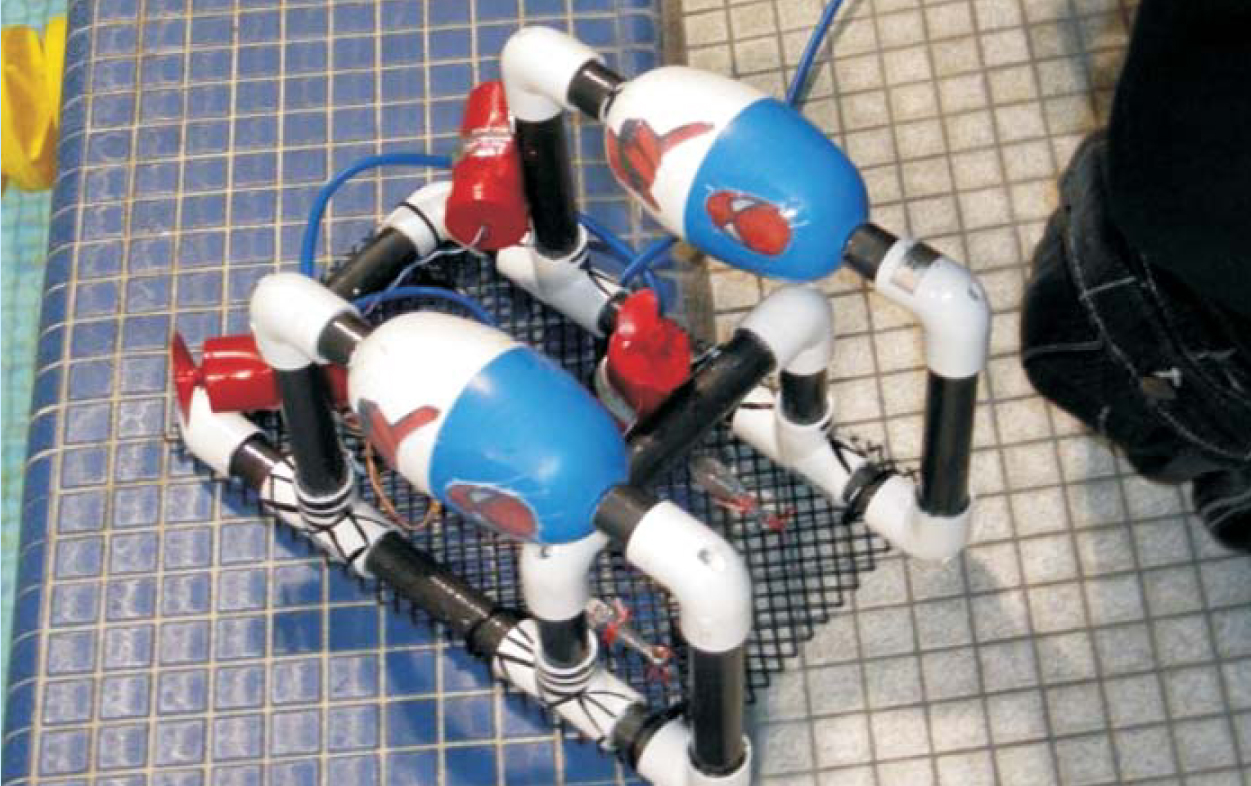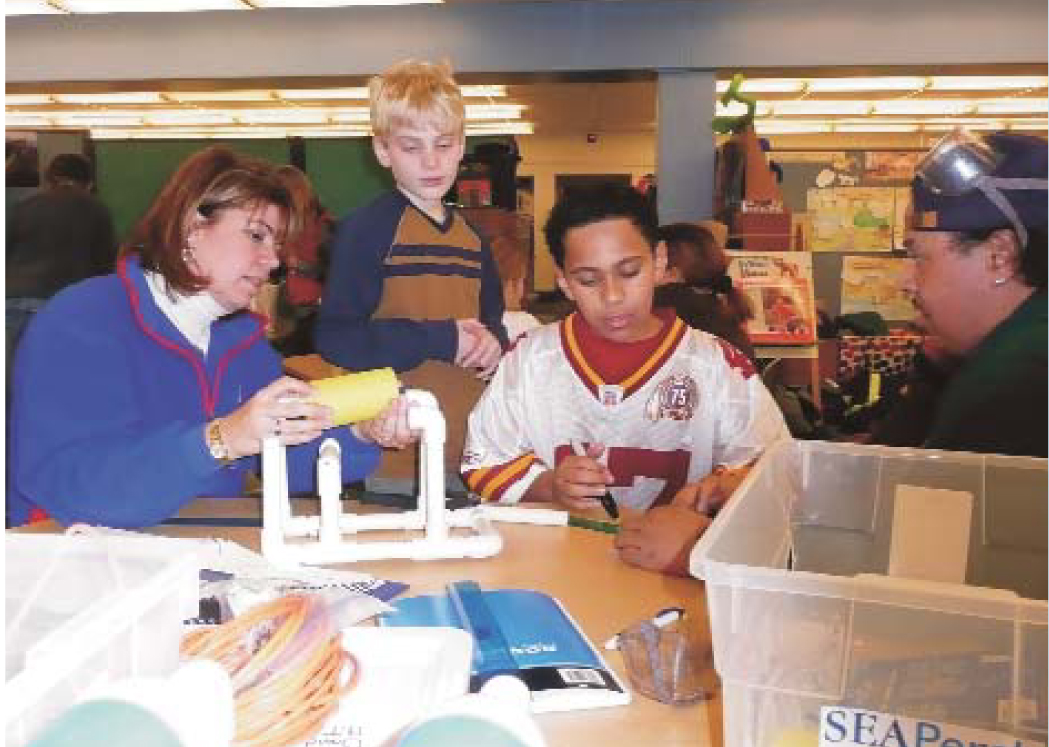Sea Perch is a fun, hands-on approach to teaching science
DOI: 10.1063/1.2897940
For Terry Anderson, learning how to build an underwater, remotely operated vehicle took her out of her “comfort zone.” But the children in her fifth-grade class at Shady Side Elementary School in Maryland seem comfortable enough assembling their own versions of the Sea Perch ROV.
Anderson and her young charges are some of the hundreds of K–12 (and some college) students who have been introduced to Sea Perch, a hands-on approach to getting schoolchildren interested in science and technology. For 10 weeks, Anderson will be showing the 10 students who stay after school for a couple of hours how to assemble their ROVs from kits consisting of such everyday items as PVC pipe and electrical tape. When the students are finished, they’ll get to take the electrically powered vehicles to a test tank at the US Naval Academy, where they’ll maneuver them by remote control. Throughout the process, the students will learn about buoyancy, displacement, and other physics principles through simple, well-crafted experiments. They also learn how to operate an electric drill and a soldering iron. Best of all, they’re having fun doing it.
During one recent class, Anderson’s students were busy cutting and drilling holes in PVC pipe and fitting and assembling the pieces into the vehicle frame. In a previous class, they learned how the perforated pipe will make the craft “flink,” or attain neutral buoyancy.
As the children await their turn with the drill, they tested Archimedes’ principle by fashioning crude model ships out of aluminum foil. Their goal was to see how many marbles they could load into the makeshift hull before it sank from the weight. By maximizing the length and width of their boats, they learned, they could increase the marble count. They recorded observations in laboratory logbooks. Asked by Anderson to explain how repeated trials are necessary in science, one savvy student explained the importance of changing a single variable at a time.
Reviewing what they had learned that day, Charlie Youngman observed, “the more weight, the more water it displaces,” while Matt Rinaldi explained that if a vessel has “solid walls,” it’s less likely to sink. For R. J. Neal, the biggest lesson was “safety first; always use goggles when drilling.”
An MIT invention
The Sea Perch program was developed in 2003 by researchers at the MIT Sea Grant program and is now operating under its second three-year grant from the Office of Naval Research. With about $100 000 from ONR per year, MIT staffers train groups of teachers to build underwater ROVs from kits that contain about $100 worth of parts. The teachers then return to their classrooms to pass their training along to the next generation of prospective scientists and engineers.
Victor Polidoro, a research engineer at MIT, says the concept was borrowed from MIT’s ocean engineering program, which for many years has assigned freshmen to build ROVs. His colleague Brandy Wilbur, an aquaculture specialist and the education coordinator for MIT Sea Grant, says the program was piloted in Boston-area schools and quickly expanded to schools in New England and other areas. In May, 42 teams from schools in the Philadelphia area will gather at Drexel University to test their skills driving their contraptions through an underwater obstacle course fashioned from hula hoops, picking up objects from the bottom, and putting them into a container. Top scorers move on to the pool’s diving section, where they must maneuver using a vehicle-mounted video camera. Florida International University plans to hold a similar competition.
Chrys Chryssostomidis, who directs the MIT Sea Grant program, is currently on sabbatical and touting Sea Perch in Europe.
Kelly Cooper, the outreach program director at ONR, says the US Navy has an obvious vested interest in expanding the pool of engineers. The number of Americans graduating from engineering programs each year, 70 000, is being dwarfed by China’s 900 000 and India’s 350 000.
Cooper says that since Sea Perch was added to the course work of an introductory marine engineering course at the University of Michigan, the class size has “maxed out” at 42 students, compared with the 20 to 25 which had been typical. Wilbur says 58% of the teachers who’ve been trained use the program for at least two years.
Virtual field trip
There’s no limit to the optional equipment that could be loaded onto the basic Sea Perch. Some places add video cameras, and simple designs for homemade pressure sensors are available. One school fashioned a hydrophone from a microphone, a film can, and some wiring, says Wilbur. So equipped, that Sea Perch was able to track down the source of the racket produced by a buzzer inside a submerged plastic bottle. The University of Hawaii streamed video from a coral reef to a website, giving students anywhere in the world a virtual field trip. With the further addition of a global positioning system receiver, the vehicle can be sent back to the precise location on the reef where it was, to provide an opportunity to see how the numbers of various organisms may change over time.
The Society of Naval Architects and Marine Engineers has embraced the Sea Perch program. Susan Giver, SNAME’s director of outreach, is working to expand Sea Perch nationally. The school Sea Perch programs are expected to become self-sustaining, and after the first year, schools will be expected to pick up an increasing fraction, if not all, of the costs, says Giver. That transition has already occurred at the Philadelphia-area schools.

An underwater vehicle ready for competition at the greater Philadelphia Sea Perch Challenge.
(Photo courtesy of SEAPerch.org.)


Fifth-graders at Shady Side Elementary School in Maryland assemble their Sea Perch. From left, teacher Terry Anderson, David Kramer (this reporter’s son), R. J. Neal, and parent volunteer Roderick Neal.

More about the Authors
David Kramer. dkramer@aip.org
